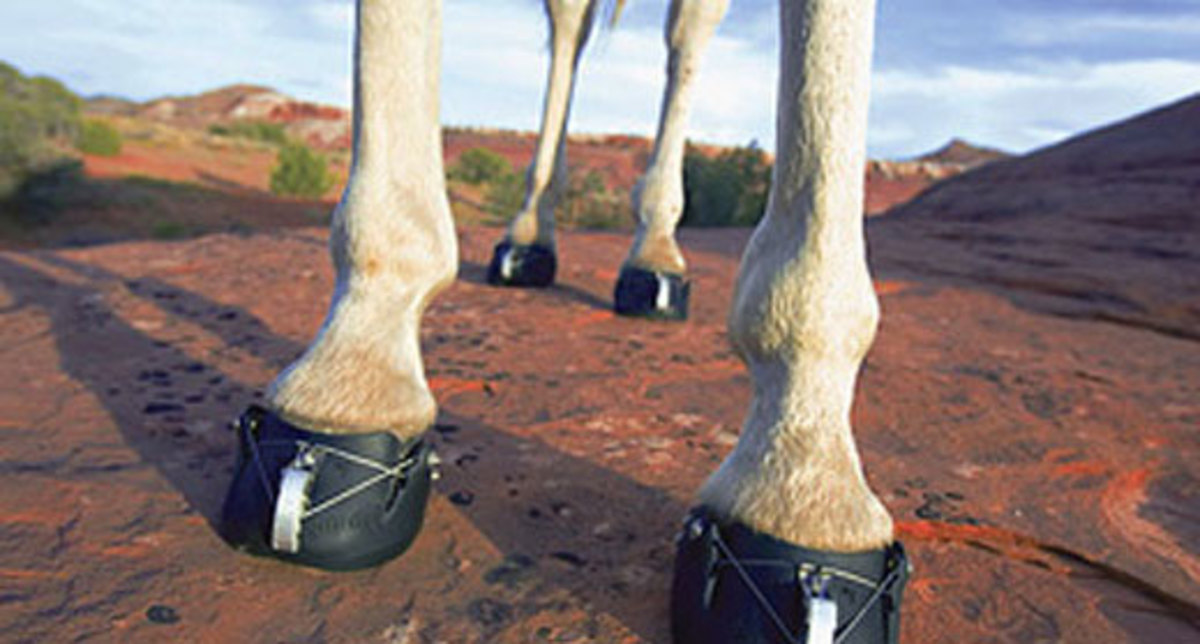
Is it a good idea? Before you invest in expensive hoof boots that may or may not be right for your horse, check out our tips, do your homework, and talk to your farrier and veterinarian. Then decide which, if any, boot is best for your horse.
[READ: 7 Worst Mistakes in Equine Hoof Care]
A New Age
A muddy section of the trail is coming up. After last weekend’s storm, a long stretch is submerged, and your horse stiffens slightly as he picks his way through the hummocks. “Please, please, don’t come off,” you whisper to yourself.
Back on dry ground, you lean over and check your horse’s feet. Success! Four wet, muddy hoof boots, snug and right where they belong.
If you’re lucky.
The New Age of hoof boots has sent trail riders online and to tack shops in search of an alternative to horseshoes. What many have found is a confusing choice between materials, designs, and sizes of hoof boots. Sorting through the models and manufacturers is made all the more confusing by glowing recommendations from riders around the globe who sing the praises of one style over all others.
On the other side of the hoof boot coin are riders who bought boots in the wrong shape or size for their horses, only to see the boots fail on the trail, or cause sores and rubbing on their horses’ pasterns and heel bulbs.
“I told you so” is something no rider wants to hear from his or her farrier and vet, so start with a consultation from one or both of your professional advisors. Chances are, they’ve seen the benefits and ill-effects of hoof boots in horses like yours, and can offer sound advice.
[READ: Hoof Care Makes the Horse]
Boot Showcase
Boa Horse Boot
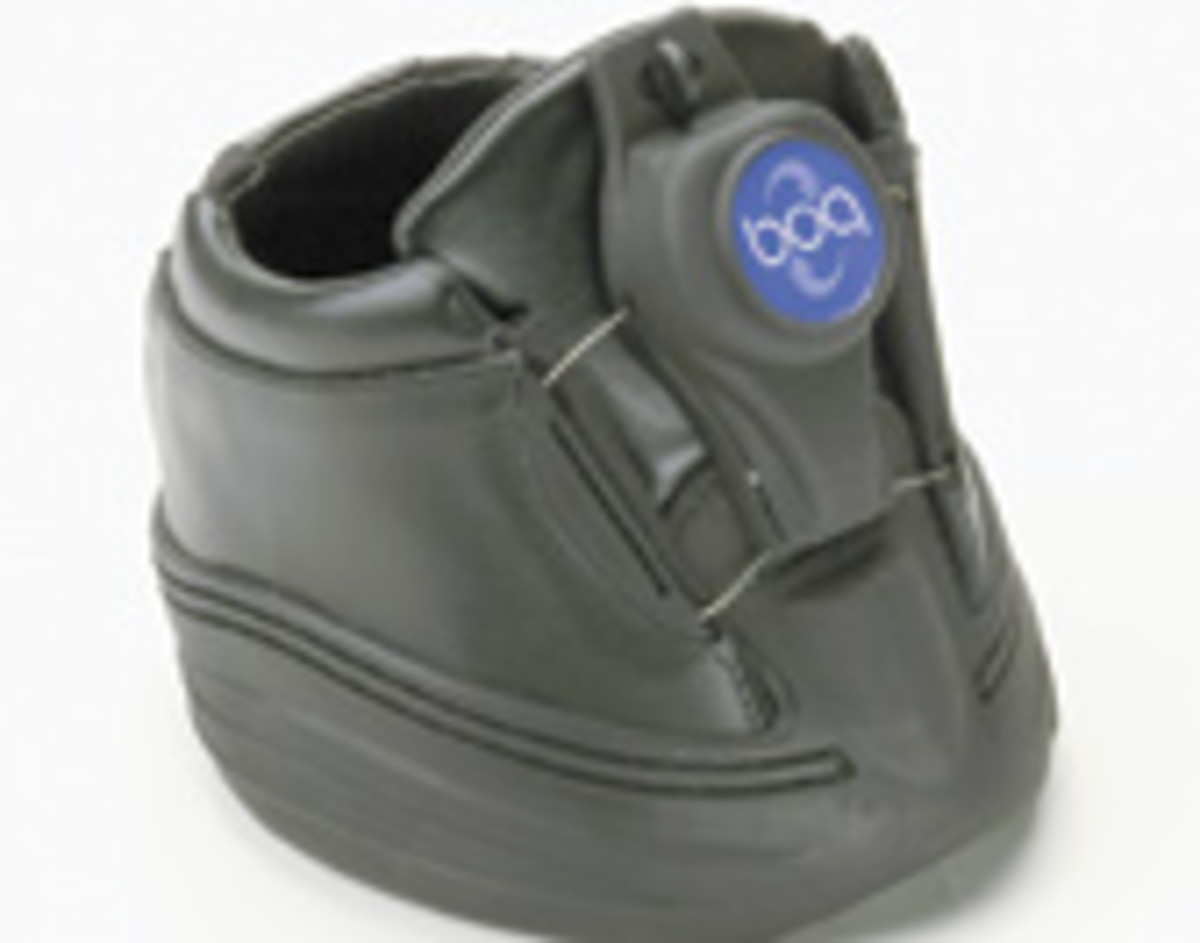
Easyboot Epic with Gaiter

Sabre Sneakers
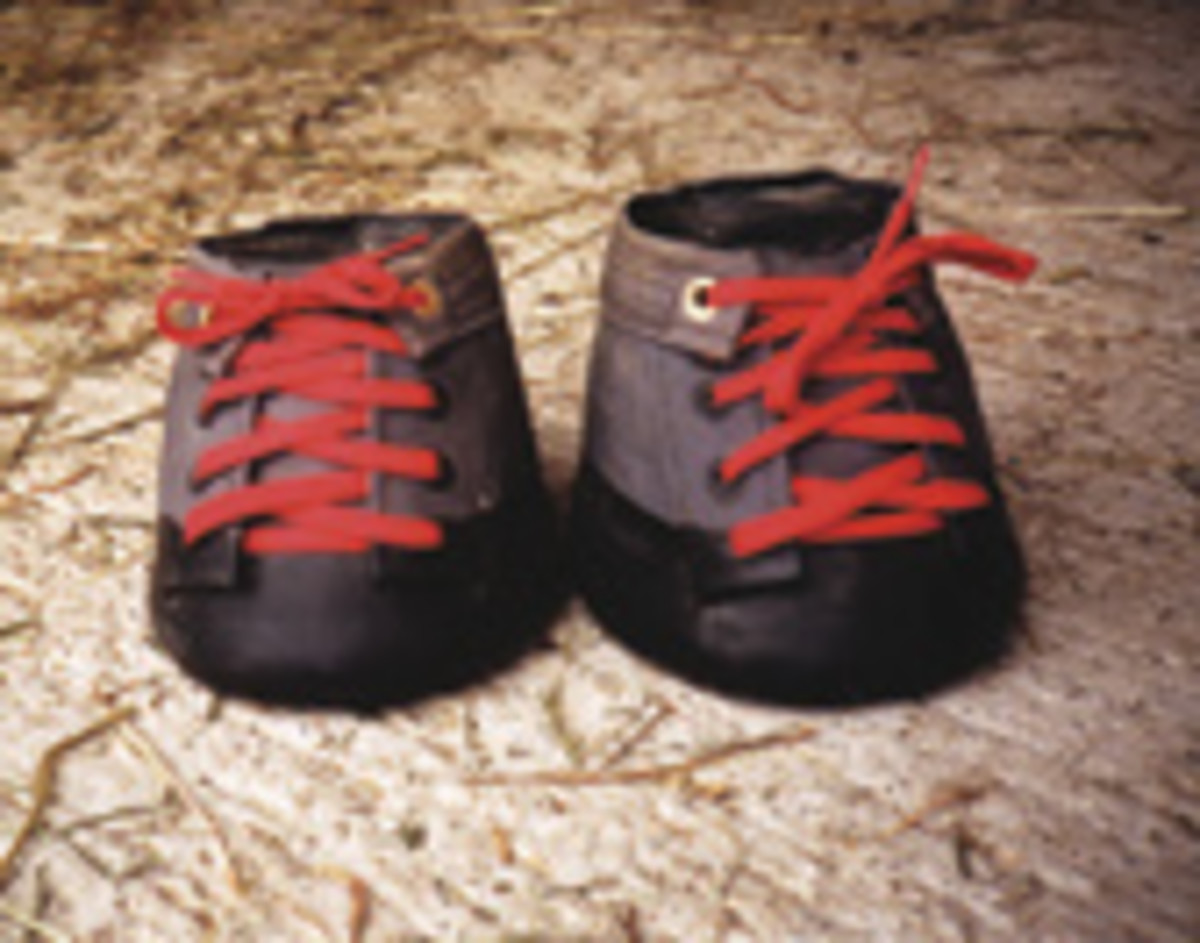
Bosana Boot
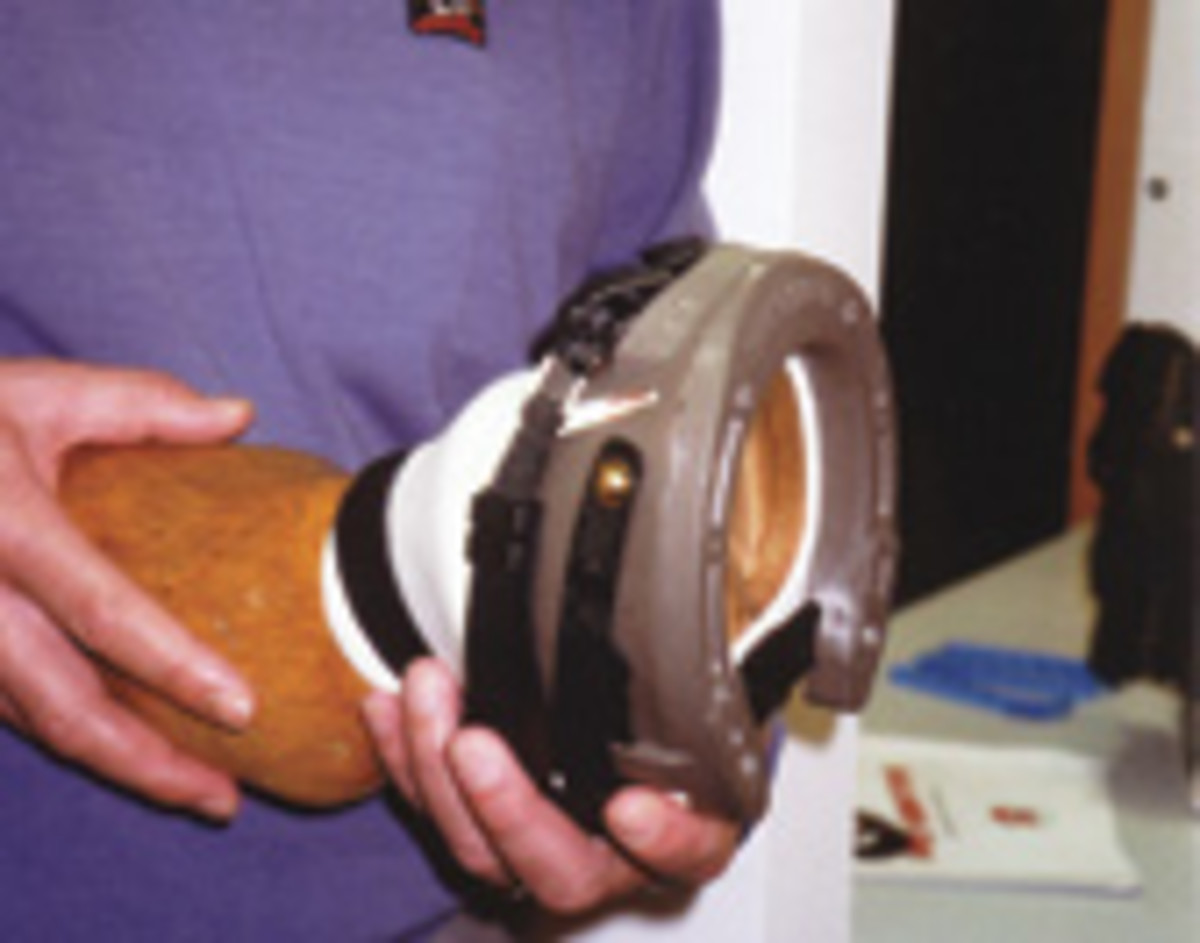
Marquis Supergrip Horse Boot
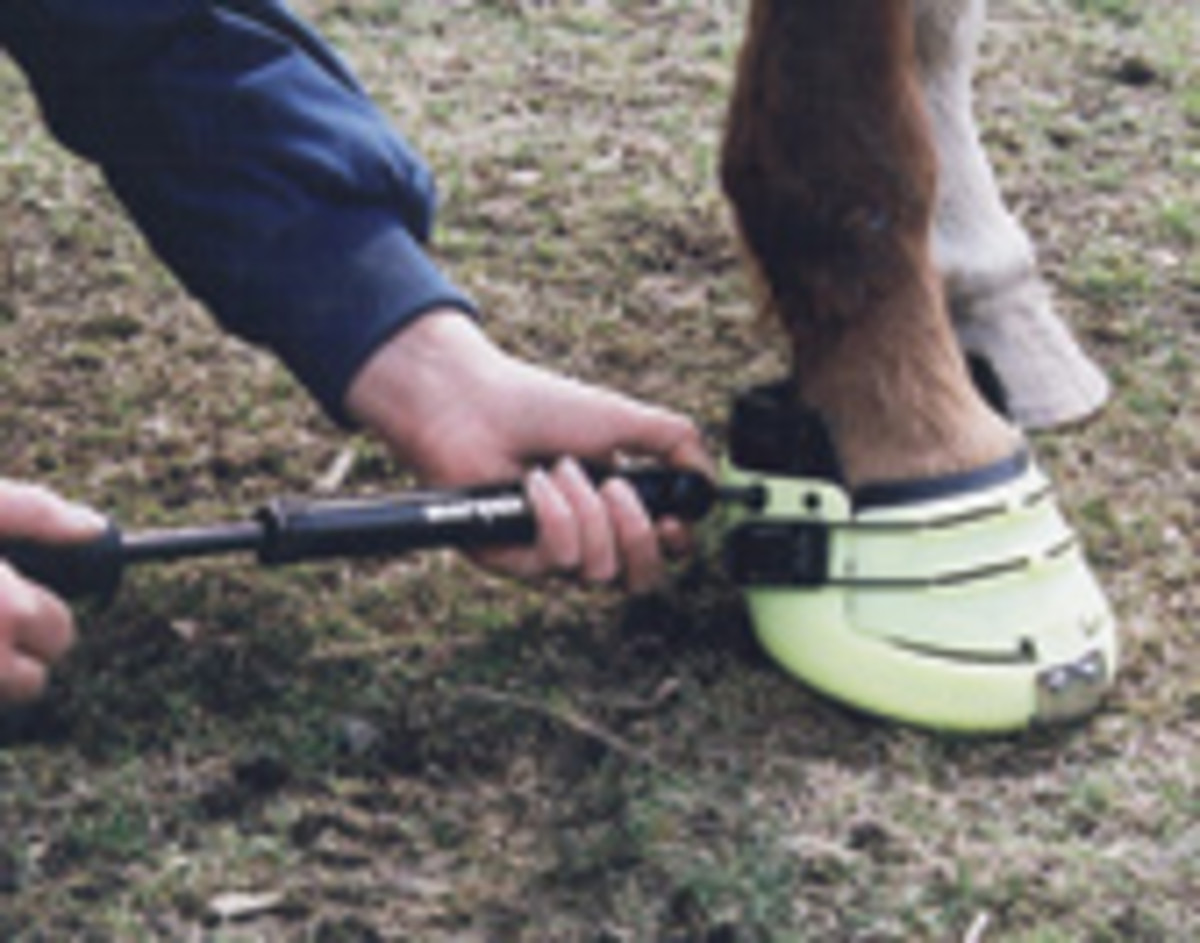
Horse-Moc
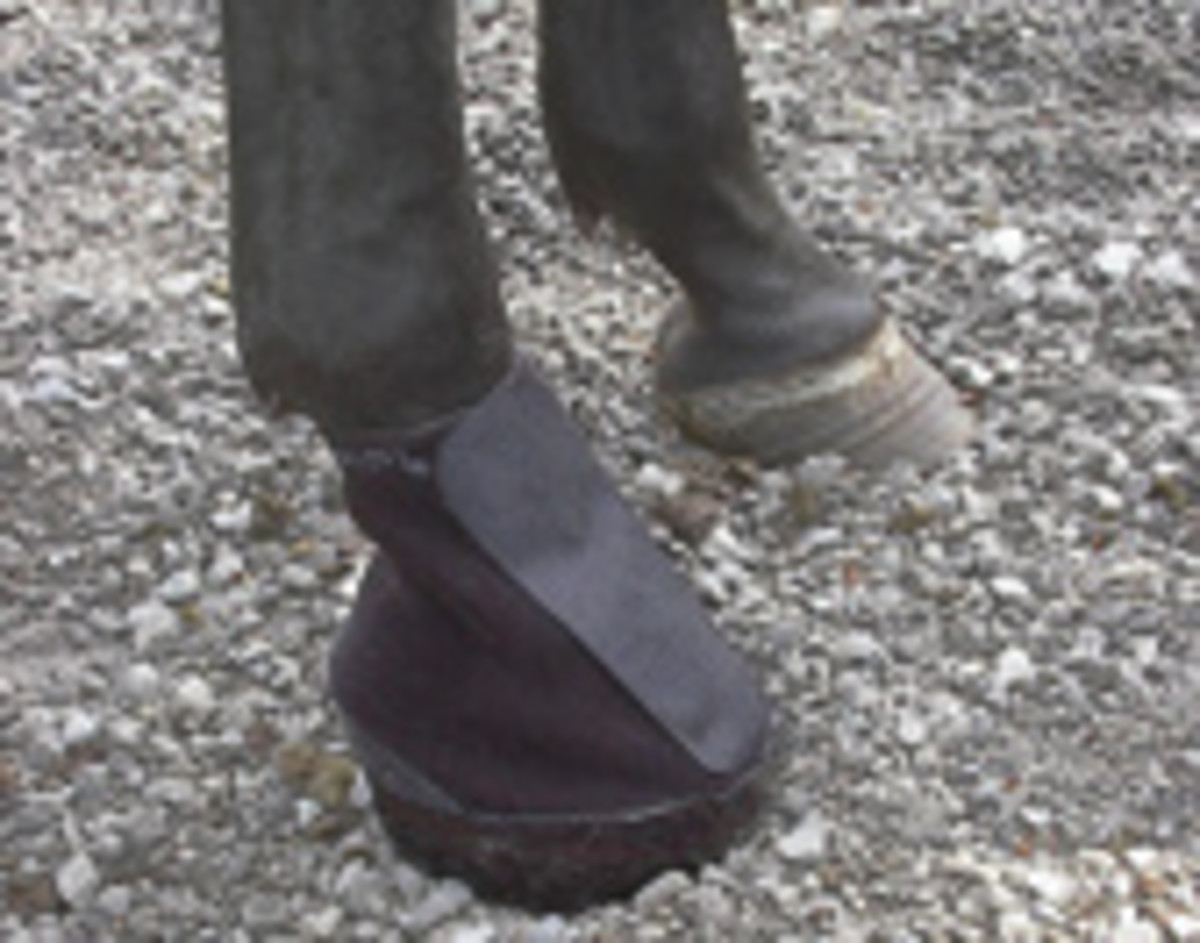
Tread Options
Boa Boot
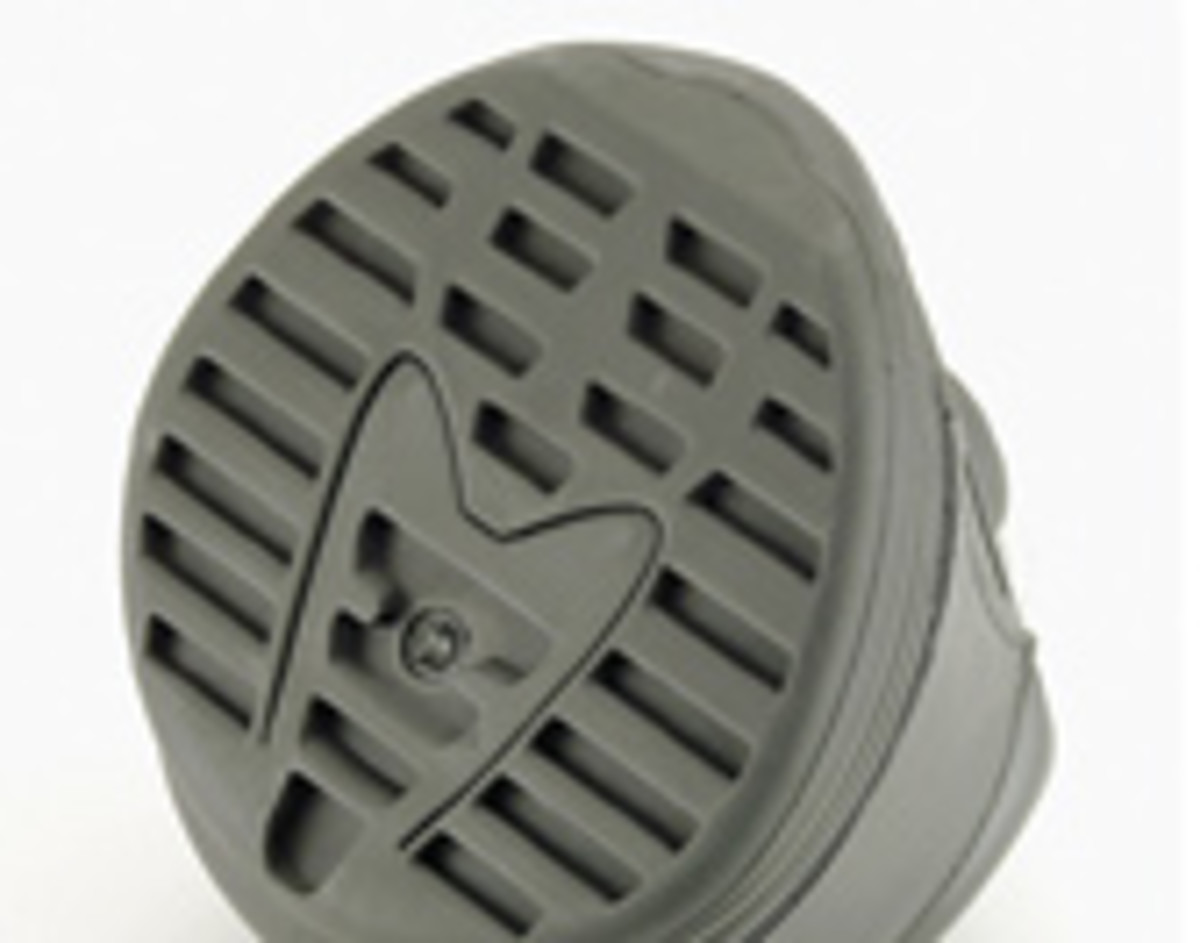
Easyboot (studded)
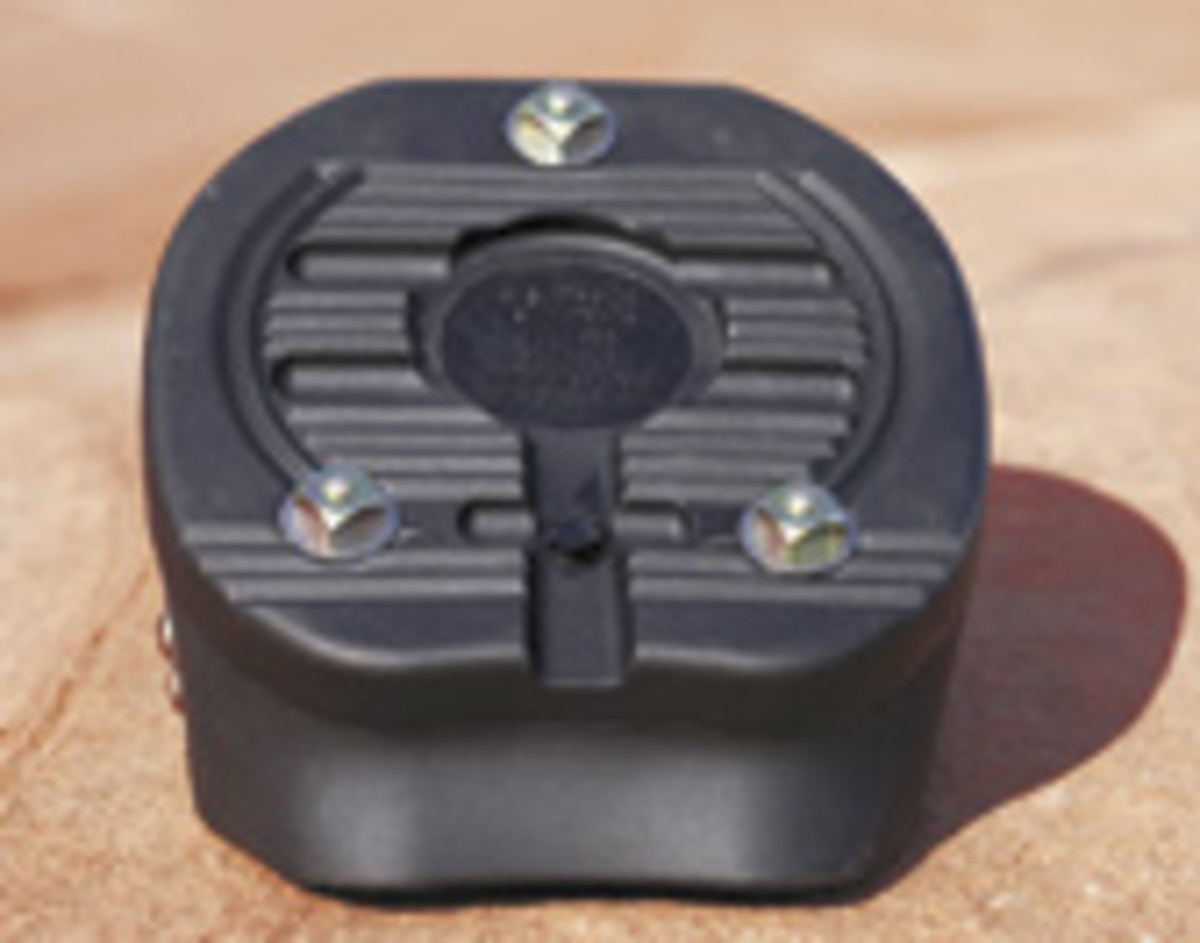
Dallmer Clog
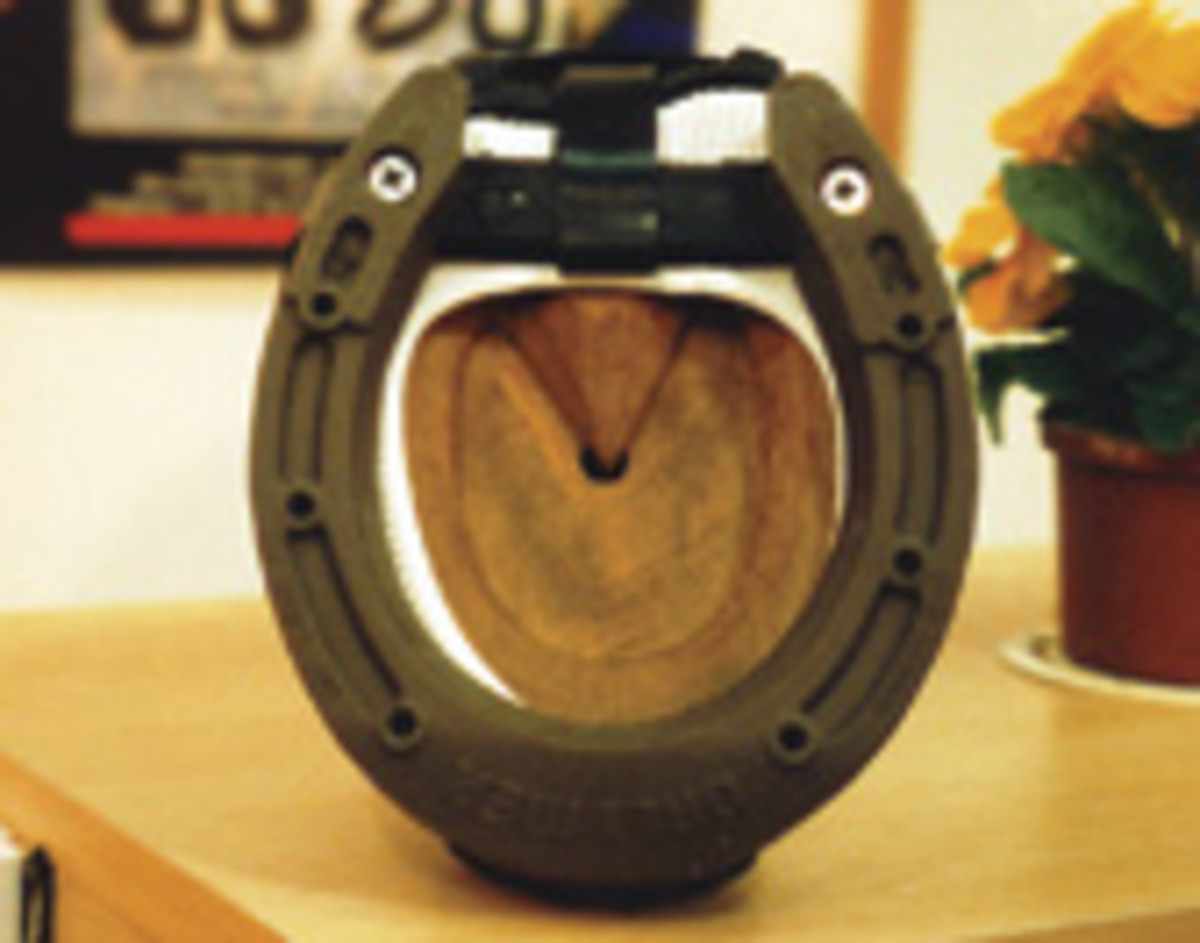
Size & Shape
You may be so accustomed to your own horse, or horses of your chosen breed, that you aren’t aware of how varied hoof shape can be. Thoroughbred-type feet tend to be more round, while those of gaited breeds may be more oval. Trying to jam an oval hoof into a round boot sounds like an old clichÈ, and it’s just as true: Find a boot shaped like your horse’s foot!
Most hoof-boot makers will advise
you to make tracings of your horse’s feet soon after trimming. Custom-made boots will require this step. By tracing your horse’s foot, you’ll clearly see whether it’s wider than it is long. Hoof boots also vary in shape.
Keep in mind that your tracings will capture your horse’s feet as they were shaped on that day. If you’ve recently removed your horse’s shoes, his foot shape may change quite a bit in the months to come. Plan to evaluate hoof-boot fit on a regular basis, or opt for boots with plenty of adjustment features.
Custom-made boots are sometimes required for hard-to-fit sizes. For instance, if you have a half-draft trail horse, you may be limited in your choices to find a boot big enough for him. You might also have a hard time finding boots for a small pack animal, such as a burro or Sicilian donkey.
[READ: Healthy, Strong Hooves]
Trail Terrain
Hoof boots offer plenty of protection for the bottom of your horse’s foot, but consider other terrain aspects. Do you ride on the beach or over sandy trails? Sand can irritate a horse’s tender skin on the back of the pastern, and a boot full of sand can be a heavy lever on the end of a horse’s legs. Look for boots with plenty of vent holes, and make sure that the holes stay open.
If you ride in sand or on pebbly ground, consider applying socks or gaiters under the boots to protect your horse’s skin. The Marquis boot from Germany offers optional Teflon socks. Old Mac’s can be paired with a pastern wrap that seals the area around the boot top. The new “Epic” design for Easyboots comes with a protective gaiter for the pastern area.
Endurance riders in Vermont who train in Old Mac’s pull athletic tube socks over their horses’ hooves and under their feet to prevent rubbing and abrasion from hard trail work before 100-mile rides. Marquis boots have an inflatable pastern collar that aids in custom fitting, but also helps keep out debris.
Water is the big test for hoof boots. Most materials won’t be affected by water damage, but the fit must be correct to keep drainage vents or holes clear of obstruction. Captive water sloshing inside a boot can affect your horse’s stride and even cause a stumble. Some horses are annoyed by water and appreciate quick drainage. Boots without drainage, such as soaking boots, shouldn’t be worn on trail for safety reasons.
Many riders report that their horses seem more surefooted when barefoot or wearing boots. An exception may be on ice and snow. A winter boot is probably on the drawing board somewhere, but in the meantime, ask your farrier about winter traction for hoof boots. Easyboots are available with optional sharp studs; the Marquis is equipped with removable studs similar to those worn by jumpers and event horses. Other boot models may also have this add-on option.
A properly fitting trail boot that’s equipped with removable traction may be a very good investment if you live in a snowy, icy climate. Remember to remove the studs during trailering, or your mats will suffer!
Booting Up
You’ve bought the boots, now what? Here are some startup tips.
• Save all the packaging and product literature that comes with your boots, especially the receipt. Read any and all advice from the manufacturer.
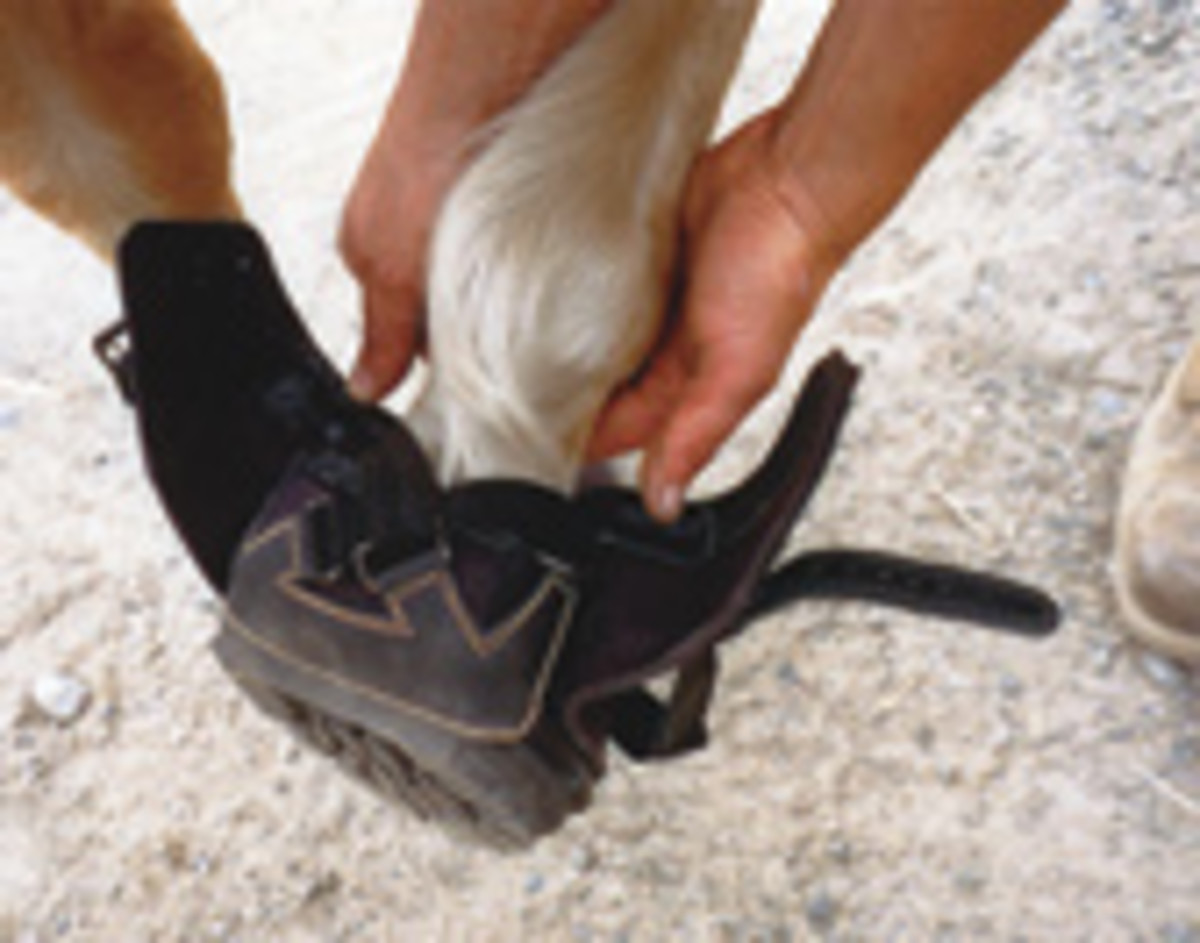
• Make a note of the manufacturer’s website and telephone numbers.
• Check photos of the boots on horses as shown by the manufacturer. Note how the boots fit in the heels and around the pastern.
• Make sure that your horse isn’t overdue for trimming, as long hooves may affect the fit.
• Schedule a quiet hour with your horse to fit the boots for the first time. Tie him safely, or have a helper hold your horse while you apply the boots.
• Photograph the boots on your horse’s feet, then remove them. Decide whether you’re satisfied with the size and fit, and the ease or difficulty of application. If you’re not convinced these boots will work for your horse, call the tack shop or manufacturer immediately to arrange an exchange.
• Apply the boots, and walk your horse. Ask him to turn, and note whether the boots twist on his feet. Judge how comfortable he appears. Make a mental note of any changes in stance, or whether the boots brush, particularly in the hind feet. Trot your horse on the lead line, and listen for an even footfall.
• Saddle up, and head out on a short trail ride over level ground. Again, listen for any changes in the normal sounds of your horse’s gaits. Ask a knowledgeable horseperson to observe your horse under saddle to see whether anything appears awkward or out of sync. If so, switch places with your helper to observe the problem yourself.
• When you’re happy with the boots, note which one is marked right and which one is marked left (if applicable). Small markings are easy to read on a new pair of boots, but will be obscured with wear. Place a dot of paint in two different colors on the inside collar of each boot to help you put them on the correct feet.
• Write your name, the size of the boot, and your horse’s name on the inside of each boot with a waterproof marker for identification purposes.
• Practice applying and removing the boots several times, until your horse is accustomed to the procedure and you can judge what the normal adjustments entail. You need to be able to remove the boots quickly in case of injury.
• Explain to barn workers and other riders that your boots are valuable, and that you plan to take good care of them. Any boots left lying around the barn should be returned to the tack room or to you to avoid confusion and to ensure the correct boot is applied to the correct horse.
Soundness Considerations
You’ve probably heard of horses that are “ouch-y” when newly barefoot, but sound when wearing protective hoof boots. Horses that are in transition from long-term shoeing to a new barefoot lifestyle need to be carefully evaluated when they show signs of hoof pain. Make sure that the cause of lameness is simply tender soles and frogs, and not an injury or disease condition, such as laminitis.
When in doubt, veterinarians advise owners not to ride a horse in boots that’s not sound without them. Chronic ligament injuries in the foot or torn laminae in the hoof wall will be aggravated by exercise, and the booted horse that trots out of the barn and onto the trail may be limping home, or need a lift.
Check with your vet before riding a horse medicated for a lameness condition.
Horses that have been barefoot for several months but are still sore-footed, or horses that become sore-footed under the weight of a rider, aren’t good candidates for hoof boots, even if they appear sound once boots are applied. They still need time to grow a stronger hoof.
Hoof boots aren’t designed to obscure signs of preexisting injury; they’re designed to protect hooves on the trail. Don’t be fooled by a temporarily sound horse; the soreness is still there and may be aggravated by forced exercise.
Many boot advocates argue that circulation is needed to improve hoof quality and growth, and that boots make it possible for horses to exercise (and thereby enhance circulation to the lower leg and foot) without pain. Make your decision with the input of your veterinarian and farrier, and make sure you know the cause of your horse’s lameness. Don’t be pressured into riding an unsound horse. If you decide to get out the hoof boots and ride, keep in mind that you’re exercising for therapy, not out for a conditioning workout.
Sometimes, small changes in hoof balance or the amount of sole or wall removed will greatly benefit a sore-footed horse. Horses that have been trimmed too short need a chance to grow more sole. Hoof boots aren’t a replacement for natural sole.
Fitting Facts
“Fit” and “size” aren’t interchange-
able terms when it comes to hoof boots. Determine the correct size for your horse in consultation with the manufacturer or
a knowledgeable tack-shop salesperson. Plan to spend some time researching models and have your hoof tracings on hand as you examine each one.
Find out in advance under what conditions the boots may be returned for a refund if they don’t fit your horse. Also ask about warranties for materials.
Ideally, you should load your barefoot horse onto a trailer and drive to the tack shop. If the shop permits, and if your trailer and horse are spotlessly clean, you may be allowed to try a boot on your horse to see how it fits.
Don’t be surprised if a boot fits your horse’s front feet, but not the hind ones. Hind feet are generally more oval, and may be a different size. Likewise, if your horse has mismatched front hoof angles – a common condition – your horse may need two different boot sizes. This can be problematic if the boots are sold only in pairs, but correct fit is imperative. Some horses wear boots from different manufacturers at the same time.
High-tech boots, such as the Swiss Horse Boot, are best used after a professional fitting by authorized farriers or hoof trimmers who specialize in those boots. Their knowledge and experience will be a great resource for you.
Boa Boots and Old Mac’s are two boots that look like low-tech alternatives when compared to the European models, but actually are quite the opposite. Both offer plenty of adjustments for odd-shaped hoof walls, but the shape of the platform under the foot still must match your horse’s hoof shape. Even with an ample hook-and-loop adjustment system in Old Mac’s, a good fit must start with selecting the correct size.
Every few months, stand back and evaluate how your horse’s hoof boots fit. Ask your farrier to check the boots and note any developing problems.
Note that you may or may not be able to use the same pair of boots for multiple horses. Over time, some boots seem to have more “memory” than others, adapting to the hooves they cover. Don’t try to make an old boot fit a new horse; the likelihood of a good fit will decrease!
Likewise, don’t share boots with friends and acquaintances, except perhaps in a dire emergency. The likelihood of getting the boots back in their original condition is slim. Plus, boots are easily lost or stolen, and any mishaps that the borrower experiences will surely be blamed on the borrowed boots.
Hoof-Boot Upkeep
Each hoof-boot model comes with its own maintenance instructions, but incorporate your own routine before and after use. Here are some upkeep tips.
• Cleaning is critical and best done immediately after use. Check all materials for wear, particularly buckles and stitching.
• If the boot uses hook-and-loop fasteners, invest in a brush designed for this material, and clean it before and after each use.
• Try to keep boots out of stalls, where shavings and sawdust can foul the material.
• After rinsing or wiping down the boots with damp sponges, dry the boots thoroughly, then store them in their natural, closed shapes in a dry place. If you hang the boots on hooks after cleaning to dry, don’t forget to put them away.
• A laced boot, such as the Sabre Sneaker, should have spare laces on hand; carefully clean the eyelets after each wearing to make the next lacing easy.
[READ: 6 Tips for Healthier Hooves]
When to Boot Boots
If your horse suffers from a chronic lameness condition or shows the effects of chronic hoof-capsule distortion (as diagnosed by your farrier or vet), deal with the problem before you attempt to boot your horse for trail riding.
Sheared heels, contracted heels, and chronic thrush are conditions that require professional assistance and diligent hoof trimming to correct. Once corrected, your horse’s foot will probably be shaped differently than before, and the wait to purchase boots will be worth it.
One aspect of hoof boots that’s rarely discussed is the horse’s own individual preference. Many horses have worn bell boots and don’t object to having their pasterns handled. Some horses seem to delight in the boots as an alternative to shoes, while others resent standing for them to be applied. Still others seem to object to having anything around their pasterns and will fidget. Your fidgety horse may calm down after a few applications, but monitor him for further reactions rather than putting yourself in danger.
Don’t force your horse to wear boots if he seems nervous or uncomfortable. Try building up wear time gradually until he becomes accustomed to the feel.
Horses that have clipped coronets and pasterns, and/or sanded hoof walls (to hold a hoof polish for showing) may need extra protection from rubbing. Check with boot makers about different ointments and barrier creams, or try Easyboots with foam padding.
Buying used hoof boots is a risk. Examine the boots carefully for wear, and try to determine whether they’ve been properly maintained. Try them on your horse before you buy.
Boots are a great choice if you know your horse well. A sensitive rider will know instantly if his or her horse is surefooted, striding out confidently, and well-balanced. Try changing leads to see how smoothly or reluctantly your horse complies. Make mental notes along the trail of fatigue, gait glitches, and head carriage.
With luck, your horse will join the boot brigade and enjoy being barefoot the rest of the day. If not, horseshoes are available in new materials and models to accommodate every horse’s needs.






